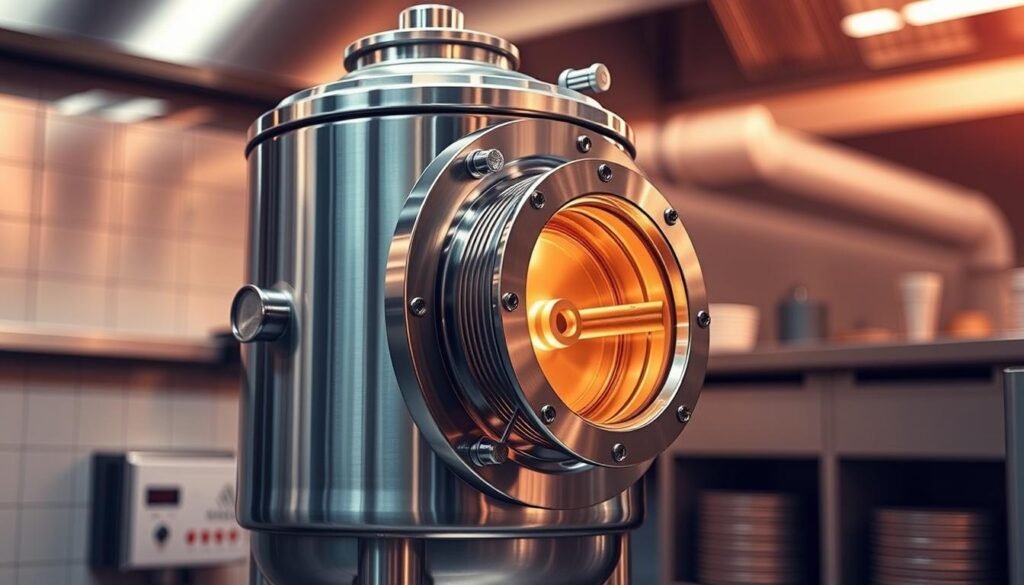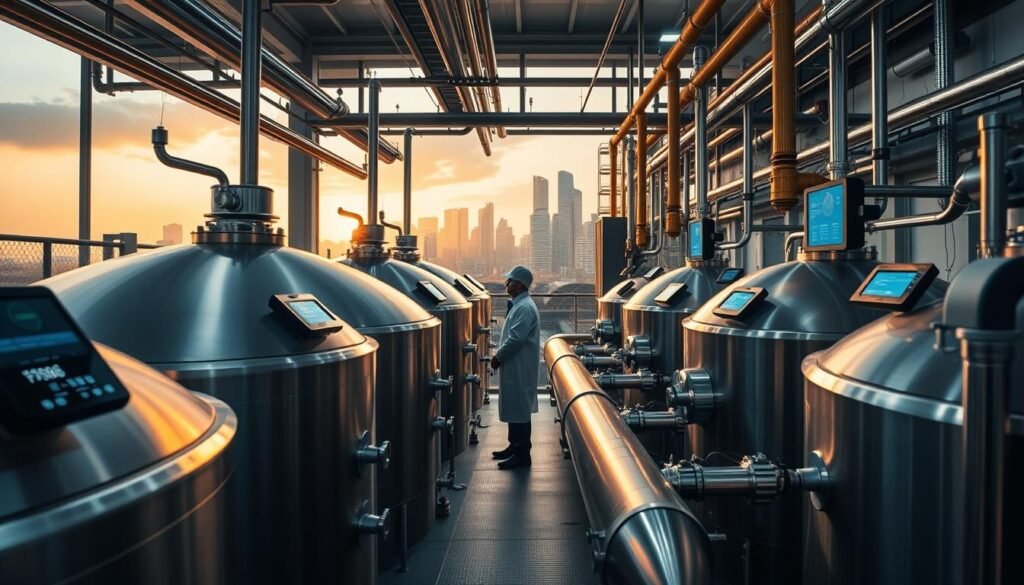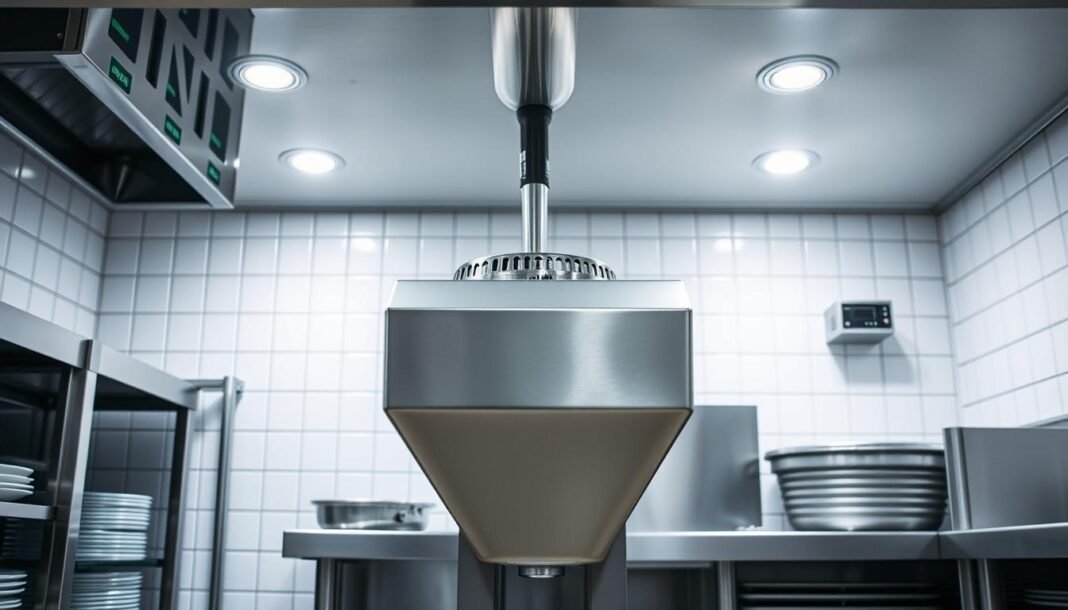Grease separators in Singapore are key to keeping our drainage systems clear. They remove fats, oils, and grease (FOG) from wastewater. This stops blockages that could damage our public infrastructure and harm the environment.
For businesses, using a grease separator singapore is a must. It follows the rules set by PUB, Singapore’s water agency. This ensures your business meets the necessary standards.
PUB rules say commercial kitchens and food places must use grease separators. This stops FOG from getting into sewers. Not following these rules can lead to fines, disruptions, and harm to the environment.
Keeping your grease separator in good shape is crucial. It makes sure you follow the law and protects your business’s good name.
Key Takeaways
- Grease separators singapore prevent costly sewer blockages and environmental harm.
- PUB mandates their use to protect Singapore’s drainage systems.
- Regular maintenance ensures compliance and avoids legal penalties.
- These systems help businesses meet sustainability goals.
- Failure to install or maintain them risks health code violations.
Introduction to Grease Separators in Singapore
Grease separators are key in managing wastewater in Singapore’s food industry. They help places like restaurants and hawker centers meet PUB’s environmental standards. Let’s see how they work and why they’re important.
Overview of Grease Separators
Grease separators clean wastewater in three steps. Here’s the process:
- Coarse solids get trapped in a pre-filter chamber.
- Oil and grease float to the top in a settling chamber.
- Clean water goes out through an outlet pipe, leaving waste for safe disposal.
Key Benefits for Businesses
Using grease separators has many benefits:
- They prevent expensive plumbing repairs from FOG blockages.
- They cut down on foul odors in kitchens.
- They help meet PUB’s mandatory wastewater guidelines to avoid fines.
| Benefit | Outcome |
|---|---|
| Odor Control | Fresher air in dining areas |
| Compliance | Avoid legal penalties |
| Cost Savings | Lower maintenance expenses |
Hawker centers with these systems see a 70% drop in drain backups. Every business handles wastewater differently. But, proper separators ensure efficiency and protect community health.
Regulatory Compliance and Legal Requirements
Keeping up with commercial grease trap rules is crucial for businesses in Singapore. The Public Utilities Board (PUB) and National Environment Agency (NEA) have strict rules. These rules protect our drainage systems and health. Not following them can cause fines or stop your business.
The Sewerage and Drainage Act is key. It requires the right setup and care of grease traps. You need a PUB permit before installing. Also, you must check your waste regularly to meet standards.
Rules in Singapore match those in the UK and US. They all aim to stop blockages in pipes.
- Apply for PUB approval before installing a commercial grease trap.
- Conduct quarterly maintenance as per NEA guidelines.
- Document all inspections and repairs for audits.
Following safety rules is as important as following laws. Training your staff on grease traps lowers risks. Using safe, certified equipment from brands like Orenco or Belkor is key. Breaking the rules can lead to fines up to S$10,000 or legal trouble.
Keeping your business clean and getting third-party certifications shows you care. This approach keeps you legal and eco-friendly.
Design and Functionality of Grease Separators
Grease separators in Singapore are made to remove fats, oils, and grease (FOG) from wastewater. They follow strict rules like BS-EN1825 and PUB’s standards. This ensures they work well. Let’s look at how these systems function and why they’re good for various places.
- Construction Materials: Durable materials like fiberglass, stainless steel, or concrete prevent corrosion and withstand heavy use.
- Size Matters: Systems vary from compact portable units to large underground tanks, sized to match kitchen or commercial waste output.
- Chambered Design: Multiple chambers slow water flow, allowing FOG to float and solid waste to settle.

Here’s how they work step-by-step:
1. Entry: Wastewater enters the first chamber.
2. Settling: Solids sink to the bottom.
3. Separation: FOG rises to the surface.
4. Outlet: Clean water exits to the sewer.
Regular cleaning removes trapped FOG and solids before discharge.
Businesses choose systems based on kitchen size and flow rates. For example, a small café might use a portable interceptor, while large hotels opt for underground tanks. Proper sizing prevents overflow and ensures compliance with environmental standards.
Key features like easy access for maintenance and certified performance ratings simplify upkeep. Prioritizing design that fits your space and capacity keeps operations smooth and eco-friendly.
Implementing Grease Separator Singapore Solutions
Effective grease management Singapore is more than just installing equipment. It needs careful planning into daily routines. Here’s how businesses can make systems work with kitchen tasks and follow rules.
Integrating with Commercial Systems
- Train staff to scrape food scraps into trash bins before dishwashing.
- Install strainers in sinks to catch debris before water enters drains.
- Designate recycling bins for used cooking oil to turn waste into a revenue stream.
Optimizing Efficiency
Here are ways to boost system performance:
- Clean grease interceptors when FOG reaches 25% capacity to avoid overflow.
- Keep a maintenance log tracking cleanings and inspections for compliance audits.
- Hydrojet plumbing lines annually to prevent hidden blockages.
Regular training and inspections reduce FOG buildup by up to 80%, according to Singapore’s National Environment Agency.
By following these steps and using automated systems, operations become smoother. Focusing on grease management Singapore best practices keeps kitchens efficient. It also protects infrastructure and the environment.
Choosing the Right Equipment for Your Business
When picking a grease separator in Singapore, match it to your kitchen’s needs. PUB rules and your kitchen’s size, output, and budget guide your choice. Here’s how to make it easier.
Assessing Business Needs
First, look at three main things:
- Volume: Know your daily water use. A small café might need a 500L unit, while a big hawker center needs a 2,000L one.
- Space: Indoor units save room but need regular checks. Outdoor ones have more capacity but need easy access for setup.
- Cost: Compare the initial cost with ongoing upkeep. Big kitchens might save money with automatic systems, even if they cost more upfront.
Comparing System Options
There are three main types for different businesses:
| Type | Pros | Cons | Best For |
|---|---|---|---|
| Gravity Grease Interceptors (GGIs) | Low maintenance costs | Large footprint | High-volume kitchens (e.g., hawker centers) |
| Hydromechanical Grease Interceptors (HGIs) | Compact design | Higher energy use | Small to medium kitchens (e.g., cafes) |
| Automatic Grease Removal Devices (AGRDs) | Automated cleaning alerts | Higher installation cost | Busy F&B outlets needing minimal downtime |
Choosing the right equipment helps you follow rules and save money. Check PUB guidelines to make sure you’re picking the right size. The wrong choice could lead to clogs or legal trouble. So, balance your needs with the rules for a good solution.
Installation and Maintenance Best Practices
Installing and maintaining grease separators correctly is key for good FOG management. Follow the rules from Singapore’s Public Utilities Board (PUB) and National Environment Agency (NEA). This ensures your system works well and meets all standards.
- Position separators near kitchen drains for easy access.
- Ensure proper slope alignment to facilitate grease flow.
- Secure permits from PUB before installation.
Maintenance Steps:
- Daily: Check grates and covers for blockages.
- Weekly: Scrape surface grease manually.
- Monthly: Schedule professional cleaning to remove trapped FOG.
| Task | Frequency |
|---|---|
| Grease removal | Every 2 weeks |
| System inspection | Monthly |
| Professional evaluation | Twice yearly |
Regular checks stop clogs that could cost a lot or lead to fines. Work with certified techs for deep cleanings and follow FOG management rules. Small businesses can use PUB’s online guides to keep up with maintenance.
Cost Considerations and ROI Analysis
Choosing the right grease separator is all about managing costs. The initial cost is important, but long-term savings often make it worth it. Many businesses in Singapore find they save money by reducing penalties and maintenance.
Restaurants using proper grease management cut plumbing repairs by up to 40%, per a 2023 study by the National Environment Agency.
Budgeting and Investment
- Start with a site assessment to match separator size to business needs.
- Compare quotes from certified installers like EnviroTech Solutions or HydroSystems Pte Ltd.
- Factor in government grants like the Enhanced Green Construction Grant for eco-friendly equipment.
Measuring Long-Term Savings
Track these benefits over three years:
- Penalty avoidance: Fines for non-compliance can reach $5,000 monthly under NEA regulations.
- Equipment lifespan: Well-maintained systems last 15+ years versus 5-7 years without proper management.
- Energy savings: Efficient models reduce water and electricity use by 15-20%.
Calculators like EnviroCost’s online tool help estimate yearly savings. Choose systems with low operational costs for steady ROI.
Retrofitting vs. New Installations
Businesses in Singapore often face a choice between retrofitting existing grease management systems or installing new ones. Both options have trade-offs that affect costs, efficiency, and compliance with PUB’s regulations. Let’s look at the key considerations.
- Retrofitting: Ideal for systems less than 10 years old. Saves up to 40% in upfront costs by reusing existing infrastructure. Allows gradual tech upgrades without full replacement.
- New Installations: Best for outdated systems or expanding businesses. Ensure compliance with modern standards like PUB’s ≤100mg/litre discharge limits.
Pub’s guidelines state:
Grease traps must be accessible for routine grease interceptor maintenance and comply with nuisance prevention standards.
Retrofitting challenges arise when older systems lack space for modern sensors or automation. This can complicate grease interceptor maintenance schedules. Meanwhile, new installations let you design systems that align with future growth, avoiding retrofit pitfalls. PUB’s Code of Practice emphasizes accessibility, making new builds easier to audit.
Cost-wise, retrofitting minimizes downtime but may face compatibility hurdles. New systems demand higher initial spending but offer long-term savings through optimized performance. Businesses must assess infrastructure age, growth plans, and regulatory alignment to decide wisely.
Innovations and Emerging Technologies in Grease Separators

Grease separators in Singapore are changing fast. New tech is making them smarter, greener, and more efficient. Let’s look at what’s coming next.
Latest Industry Trends
- Sensor-based monitoring systems track flow rates and alert maintenance teams automatically.
- Self-cleaning models from brands like Ovivo reduce manual labor by 40%, per 2023 case studies.
- Bio-degradable materials now used in tank construction cut environmental impact by 30%.
| Old Tech | New Innovations |
|---|---|
| Manual inspections | AI-driven analytics |
| Steel tanks | Recycled polymer composites |
| Annual maintenance | Predictive maintenance alerts |
Future-Proofing Your System
Businesses in Singapore can adopt these strategies:
- Install IoT sensors for real-time data tracking.
- Choose systems compliant with upcoming NEA 2025 standards.
- Partner with suppliers offering software upgrades for long-term support.
“Adopting smart grease management isn’t optional—it’s a competitive advantage.” – Sustainability Report, NCH Asia Pacific
Conclusion
Managing grease properly is key for a sustainable business. In Singapore, where kitchens are busy, good grease management is crucial. It keeps your business safe and the environment clean.
Following local rules helps you avoid fines and keeps customers happy. Keeping your systems running smoothly saves you money and time. Using the latest technology keeps you ahead in the kitchen game.
Studies show that good grease management is good for the planet and your wallet. By choosing the right solutions for your kitchen, you help the environment and work better. Upgrading your equipment makes waste management easier and boosts your team’s performance.
Keeping up with new tech, like smart sensors, makes your systems better for the future. Simple steps like regular checks and new gear upgrades add up. Good grease management is not just about rules; it’s about being a responsible business and helping the city stay clean.
Start making changes today to protect your business and Singapore’s environment. It’s a smart move for your future.




